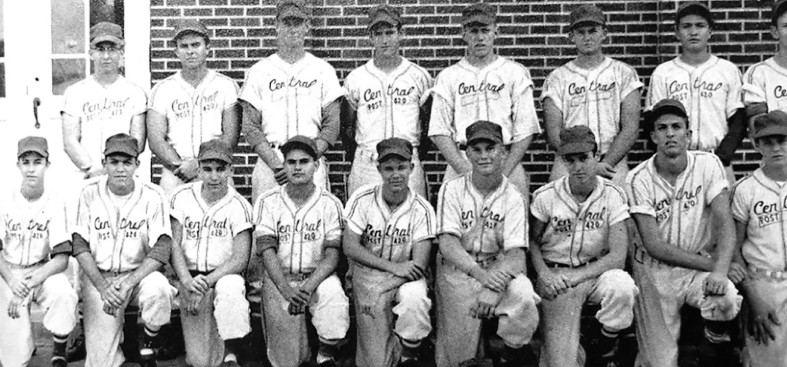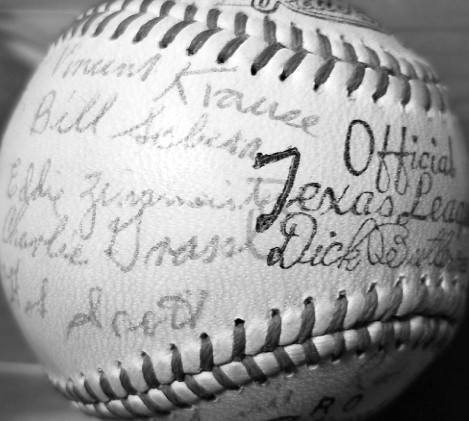An Encounter with Cliff Gustafson
This article was written by Charlie Grassl
This article was published in The National Pastime: Baseball in Texas and Beyond (2025)
The 1957 American Legion Central Catholic Team. The author is in the front row, furthest to the left. (Author’s collection)
Attend most high school baseball games in Texas today, and you will encounter a beautiful stadium with a staffed food shack. The walled outfield is most likely carpeted with neatly trimmed artificial turf, and a warning track encircles a carefully manicured infield. The helmeted players are impeccably dressed in ultra-clean uniforms that appear to have been individually sized and fitted to each player by elite tailors.
Such was not the case for those of us who were privileged to play high school baseball in the late 1950s. Most games were played in city parks, on baseball diamonds also used for family games, picnics, and parking cars. Dugouts and backstops were made from chain-link fence. The backstop was not there to protect spectators, but to stop errant pitches or overthrows to the catcher. Most fields had no outfield fences. Players wore baggy, ill-fitted flannel uniforms, batted without helmets, and played the whole season with a team supply of only five or so wooden bats. A broken bat was viewed as worse than a strikeout. During most at bats, the coach’s usual shout was, “Keep the trademark up.” Foul balls not captured by the backstop were hastily hunted down, usually by a bench player or someone’s little brother, who quickly returned them to the umpire.
Despite the contrasts in uniforms, facilities, and equipment, all eras of baseball share the joys of exciting one-run games, key game-winning hits, difficult balls caught, and speedy runners stealing bases. I attended Central Catholic High School in San Antonio, Texas, 1954-58.
At that time Central Catholic was a member of the Texas Catholic Interscholastic League (TCIL) along with other Texas Catholic schools.1 This organization functioned much like the Texas University Interscholastic League (UIL), conducting athletic championship playoffs and regulating sport competition between its member schools. Though not eligible to pursue a UIL Baseball Championship, Central Catholic scheduled games with San Antonio’s major high schools, February through May. In the 1958 high school season, Central played Alamo Heights, Harlandale, South San Antonio (known as South San), Northside, and Edgewood high schools, going 9-6 against this competition. We were also fortunate to be eligible to play as a team in a second season: a summer of American Legion baseball.
In the summer, Central was sponsored by American Legion Post 420 and played in San Antonio’s District 28 American Legion League. Members of District 28 were Central, Jefferson, Breckenridge, Alamo Heights, South San, and Burbank high schools. Despite the organizational separation of parochial and public schools, significant interplay was made possible by the cooperation of each of the coaches and the openness of the American Legion.
The Central Catholic team matured that summer of 1957, learning to compete with the best high-school competition San Antonio could offer. The American Legion summer season ended with a three-game series between Central and Jefferson High School for the District 28 title. After a split in the first two games, a third game was necessary to determine the champion.
Falling behind, 8-3, early, Central rallied for four runs in the sixth and seventh innings to close the gap, 8-7. With two outs and the tying run on base, Jefferson pitcher Garret Steubing got the strikeout and the victory for a very deserving Jefferson team. Though we were disappointed by the heartbreaking loss, we were consoled when our roster dominated the postseason All-Star team, with six of the sixteen players chosen coming from Central.
The exciting summer of 1957 passed into fall and my senior year in high school began. It would be a long wait until February and the start of the 1958 high school baseball season, but a world event deflected my focus from baseball. The event on October 4, 1957, was the Russian space launch of a tiny satellite that circled the globe, going “beep-beep” periodically. Influenced by the panic within the United States over the technological gap between the US and Russia, my dream of a baseball career changed to a career in engineering. A huge factor also was realizing I might not be good enough for the next level of baseball. Engineering might perhaps be better suited for my gifts and talents. This may have been my first measured and mature thought in high school. Nevertheless, I remained very excited about the 1958 high school baseball season.
Eventually mid-February workouts began. Our 1958 season began March 12, on a cold and wet afternoon at East Central High School, giving up a five-run lead in the bottom of the seventh inning to lose, 9-8. Winning ten of the next eleven, however, eased the pain of that first loss. Our overall record for the 1958 season, including the playoffs, was 21-8.
We were blessed to receive excellent coaching from William Kennealy. A World War II veteran, he had left the military for the religious life, becoming a Brother within the Society of Mary. He was my math teacher as well as our baseball coach. From St. Louis, Missouri, he was a fanatical fan of the St. Louis Cardinals. His World War II experiences of “flying the hump” shaped his life and all of us on the baseball team were the undeserving recipients of a man who rededicated his life to serve others.2 When I was a sophomore aspiring to play shortstop, Brother Bill many times stayed after practice to help me become unafraid of a ground ball, hitting grounders to me until I did not raise my eyes from the ball. His comment to me was always, “Good shortstops do not have sunburned eyeballs.” He taught me to watch the ball go into my glove. He was always firm yet encouraging to each of us as we developed into better baseball players and mature young men under his influence.
The highlights of the 1958 season were many, but one was to play South San, coached at that time by one Cliff Gustafson. Though we could not have known Gustafson would later be inducted into the College Baseball Hall of Fame, 1958 was South San’s first of seven UIL Texas State Championships under his leadership.3 We played them twice that year and beat them both times. Our first game, on March 26, was most memorable for me as I drove in three of the four runs in our 4-2 victory, including a home run in the sixth inning, breaking a 2-2 tie. It was my only high school home run. After the game, Gustafson took the time to tell me, “Nice game, kid.”
A month later, on April 28, we beat South San a second time, 9-5. Gustafson went on to coach another nine years at South San, capping off his time there in 1967 with a perfect 39-0 that season. He left South San to accept Darrel Royal’s job offer of to become head baseball coach at the University of Texas in Austin.4 As the Longhorn baseball coach until 1996, Gustafson’s teams won 79.2% of their games, twenty-two Southwest Conference (SWC) titles, made seventeen College World Series appearances, and won two national championships.
The irony of the 1958 season was that Central also won a baseball championship: the 1958 Texas Catholic Interscholastic League (TCIL) championship.5 The tournament was held at Keefe Field at St. Mary’s University over the weekend of May 9-11. Entering the double-elimination tournament with a 15-7 record gave us confidence that we could win the whole thing, but perhaps overconfidence was in play. Our first game, at noon Friday, was an easy, 7-3, win. Our second game was at three o’clock, against St. Joseph of Victoria, Texas. They were the 1957 TCIL champions, the ones who had defeated us in the championship game by one run.
I remembered that 1957 championship game well. I had been the one who struck out to end the game with the tying run on third base, swinging and missing a very slow change-up for the third strike. Emotionally crushed by my failure, unable to leave the batter’s box, I saw Brother Bill running toward me from his third base coaching position, He put his arm around me and told me, “That was just one of twenty-one outs, Charlie. We had many opportunities to win this game. This was just one of those opportunities.” It was a healing moment to be given that perspective of my strikeout. Always to see disappointments in a larger context of life.
In our second tournament game, our play was sloppy and careless, and we lost once again to the same St. Joseph team, 8-7.
Brother Bill was not pleased with our performance and clearly expressed those feelings to us in the postgame dugout briefing. In a most unfeeling tone, he informed us our next game, in the loser-bracket, was Saturday at nine o’clock in the morning. The meeting ended with his admonition: “Show up tomorrow only if you want to play like you know you can.” Saturday at 8:00 AM sharp, everyone showed up for warm-ups. We went about our routines quietly, without much chatter. What lay before us seemed too much to comprehend, causing us to focus on only the game immediately in front of us. That attitude prevailed throughout the whole of Saturday: play one game at a time. By the end of the day, we had won three games (one of them a 1-0 victory over St. Joseph), making us eligible to play the tournament’s only undefeated team, St. Thomas High School of Houston. We would play them Sunday at 1:00 PM.
The “one game at a time” attitude carried over from the previous day. We didn’t even think about having to play two games to win the championship. The 1:00 game was all there was. My own interpretation of my personal attitude was that we had screwed up by losing that second game, and we were being punished by having to play as many baseball games as you could fit into a weekend. It was Saturday night before we realized we had played five baseball games in two days.
When the game arrived, Central jumped out to a 7-0 lead after one inning and then padded that lead in the latter innings, resulting in an easy, 13-3 win. Central pitchers held St. Thomas to two hits. That put us in the position to play in the championship game. In the deciding game, once again, Central jumped to a lead after the first inning, this time 3-0, and adding another two runs in the bottom of the sixth. St. Thomas rallied for two runs in the top of the seventh, but that was all. The last out of the game was a pop-up to shortstop, and we won the tournament.
It was an exhausting experience to play seven games in three days. We discovered what the term “grind” meant. But soon I was rested, and the numbness of the “grind” had been overcome. Next was a celebration banquet for the team. A graduation ceremony. Then a seventy-two-mile drive to Austin, where I began my engineering studies at the University of Texas summer school session.
As the spring of 1959 came around, I thought about how much I would love to play for the Longhorns. Without a scholarship, I would have to be a walk-on. There was a high chance that I would not make the team. One of my Central teammates, Jeff Nesrsta, did make the Longhorn team. Bill Sebera, our catcher, signed a minor league contract with the Dodgers, eventually reaching as high as A-Ball. In the end, I chose to be an engineering nerd with a slide rule on my belt. Over the years I experienced a few moments of sadness over ending my baseball life at eighteen years old. But playing church-league softball and slow-pitch beer league games until the age of fifty-five, plus a wonderful engineering career, has proved adequate for a happy and satisfying life. I have been blessed.
CHARLIE GRASSL is a long time SABR member, a graduate of the University of Texas and currently retired from Texas Instruments/Raytheon. Born in San Antonio, Charlie grew up on Texas League baseball. Charlie and his wife Carole now live in Arlington, Texas. At Globe Life Field, he is one of the remaining few who “keep score” at Texas Rangers games. This is his second writing project after contributing to the SABR publication “The Team That Couldn’t Hit: The 1972 Texas Rangers.”
Central Catholic Team Autographed Ball presented to Team Captains, Bill Sebera and Charlie Grassl. (Author’s collection)
Notes
1. The TCIL ceased operation in 1978 and its members joined the Texas Association of Private and Parochial Schools (TAPPS).
2. “Flying the Hump During World War II,” Lyon Air Museum, https://lyonairmuseum.org/blog/flying-hump-during-world-war-ii/, accessed February 17, 2025.
3. University Interscholastic League, https://www.uiltexas.org/history/time-line, accessed February 17, 2025.
4. “Coach Cliff Gustafson 1,” Texas Legacy Support Network: The History of Longhorn Sports, October 13, 2021. https://texaslsn.org/new-page-cliff/, accessed November 27, 2024.
5. The Central Catholic varsity sports teams were known as the Buttons. The high school and St. Mary’s University (the Rattlers) were founded and managed by the same order of religion, The Society of Mary. The name “Buttons” referred to the part of a rattlesnake’s tail that rattles, thus linking the two schools. Unfortunately, we were often demeaned by linking the “buttons” name to the round plastic objects that hold garments closed.



